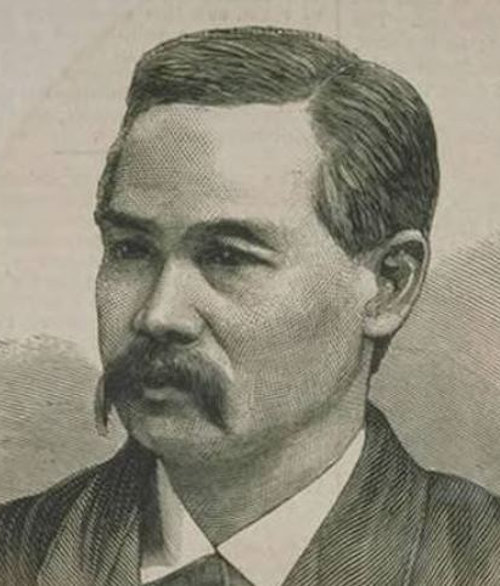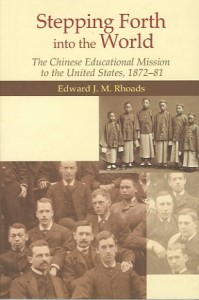Note: This article includes certain images that are, by 21st century standards, objectionable. They were, or should have been, similarly repugnant 150 years ago. But they are important examples of what minorities, including Williston’s first group of Chinese students, had to endure at the time. Recent national controversies have served to remind us that if we do not confront and acknowledge our mistakes, then progress is impossible.
The Earliest International Students
Williston Seminary, founded in 1841, had an international student clientele from the very beginning of its history. Among the first students to enroll were brothers Warren and J. Evarts Chamberlain, from the Sandwich Islands, now Hawai’i. They, like many students from abroad, were the children of Christian missionaries, sent home for the very practical reason that there were no secondary schools available where their parents were stationed. In the first two decades missionary children also arrived from Turkey and Syria. In the 1860s we start to see scholars from Persia and from South Asia: India, Ceylon. But East Asia is not represented at all. And indeed, one might argue whether an American living abroad, even if born there, might truly be called an “international student.” Meanwhile, the great majority of students hailed from the Northeast.
The very first “real” international student, one Sumner Bridgman, arrived in the fall of 1844, from Saint-Pie, Quebec, Canada. Not especially exotic, to be sure, but in any event, he didn’t stay long. He was followed in 1845 by compatriot Mary Pomeroy of Compton, Quebec, who had the distinction of being not only Williston Seminary’s first female international student, but also the last. (See “A Perfect Paradise on Earth.”) The first European students were William Marcussohn, of Odessa, Russia, who arrived in the fall of 1847, and Francisco Leiro, from Corunna, Spain, in 1848. The names and origins of all Williston students are exhaustively recorded in the Annual Catalogue of Williston Seminary. Unfortunately, prior to 1873, individual student transcripts (if they ever existed) do not survive, so we rarely have much contemporary detail on the lives of many students at the time of their enrollment.
The population of “true” international students started to grow in 1869-70. In the next four years the school would welcome multiple students from Denmark, Turkey, and notably, Japan. Then, beginning in academic 1875-76 and culminating in 1880-81, eleven young men from China would enroll. They attended under the auspices of a remarkable program, the Chinese Educational Mission (CEM).
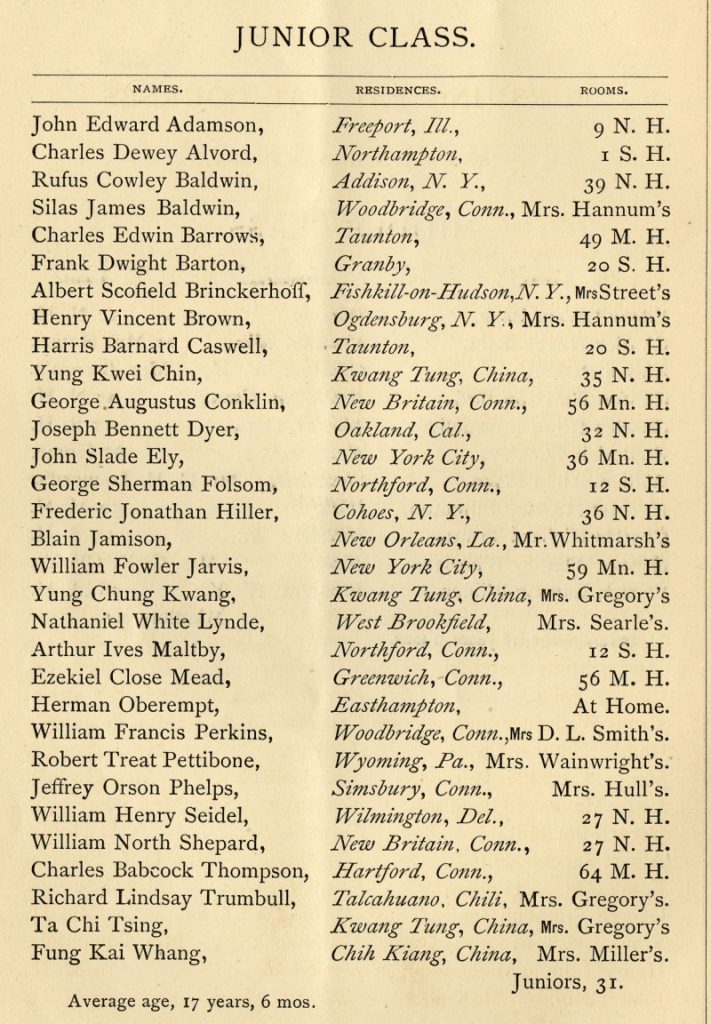
A Note on Sources
The history of the Chinese Educational Mission has been treated in two excellent volumes, China’s First Hundred: Educational Mission Students in the United States, 1872-1881, by Thomas E. LaFargue (1942), and Edward J. M. Rhoads’ Stepping Forth Into the World: The Chinese Educational Mission to the United States, 1872-81 (2011). Professor Rhoads made extensive use of the Williston Northampton Archives in researching the latter. Full citations for both volumes are at the end of this post. Both books are highly recommended
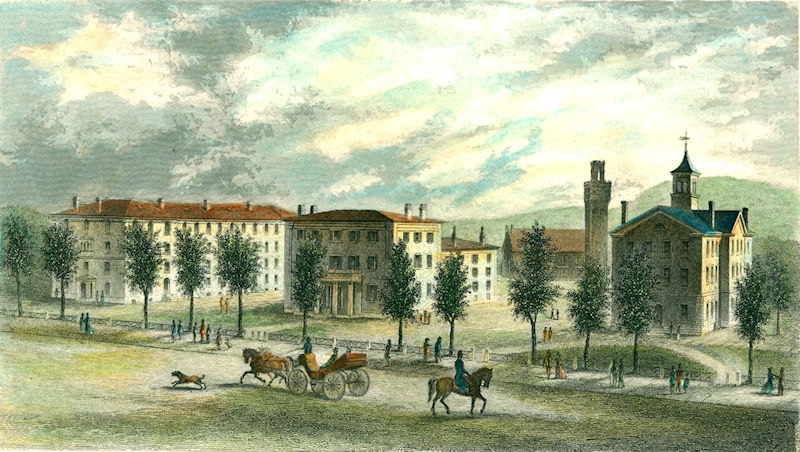
China and the West
19th century China was largely, and by design, a society isolated from the rest of the world. Modernization – of the government, the military establishment, the educational system – came slowly. Efforts were made to limit exposure to unwelcome ideas that contradicted or distracted from centuries-old Confucian principles. Until mid-century, China had only one major international port of entry, the southern city of Guangdong (Canton). The British had used it to gain access to and influence in the interior. In a particularly cynical effort to gain leverage, Britain, whose East India Company held a monopoly on Indian-grown opium, had encouraged the use of the drug in China to create a demand for it. Opium could then be traded for Chinese silks, porcelains, and other goods much in demand in the West. This had been going on since the 1780s, but it eventually led to the First Opium War of 1839-1842. Hopelessly outgunned, China was forced to make significant concessions to Britain. A second conflict, 1856-1860, which also involved France, was even more disastrous for China. Opium was virtually legalized, ten treaty ports were established along the coast, and China was forced to move her capital to Nanjing after the British occupied Beijing (Sizer, 33-40, 48). But finally, even in the most conservative government circles, it was becoming apparent that access to Western technology, both military and industrial, was essential. This eventually led to the establishment of the Chinese Educational Mission.
The evangelical spirit of the times served only to exacerbate the situation. With European traders and soldiers came a wave of missionaries. True, there had been a handful of Christian proselytes in China since the thirteen century, but their impact was slight. This time it was different; it seemed that “the conviction of Europeans that it was their Christian duty and the manifest destiny of the people of the Occident to bring to China the fruits of western civilization was accepted without question” (LaFargue 1). As shall be seen, this dynamic would effect the CEM students in both the restrictions placed upon them by their Chinese sponsors, and the expectations made of them by their American hosts.
The Chinese Educational Mission
Yung Wing (1828-1912) shepherded the Chinese Educational Mission into being. Initially taught in a Christian mission school in Guangdong, he had accompanied one of his teachers to the United States and completed his education there, eventually graduating from Yale in 1854. He may well be the first Chinese national to obtain an American education (LaFargue, 18). While at Yale he had become convinced of the need for China to explore Western educational and technological models as alternatives to the traditional systems. Although he had taken American citizenship, he returned to China in 1854, and became a tea merchant and translator. Eventually he found himself in a position to lobby officials in the Imperial court about his idea for educating Chinese boys abroad (LaFargue 17-31). He became associated with a powerful official, Zeng Guofan (Tsêng Kuo-Fan). In 1864-65, on Zeng’s behalf, Yung went back to the United States to purchase machinery for a modern arsenal and shipyard. Zeng, who shared Yung’s passion for military, industrial, and educational reform, had substantial leverage in the Imperial court (LaFargue 24-28). Thus, in 1870, the Chinese Educational Mission was approved. Yung Wing was named one of the Governors.
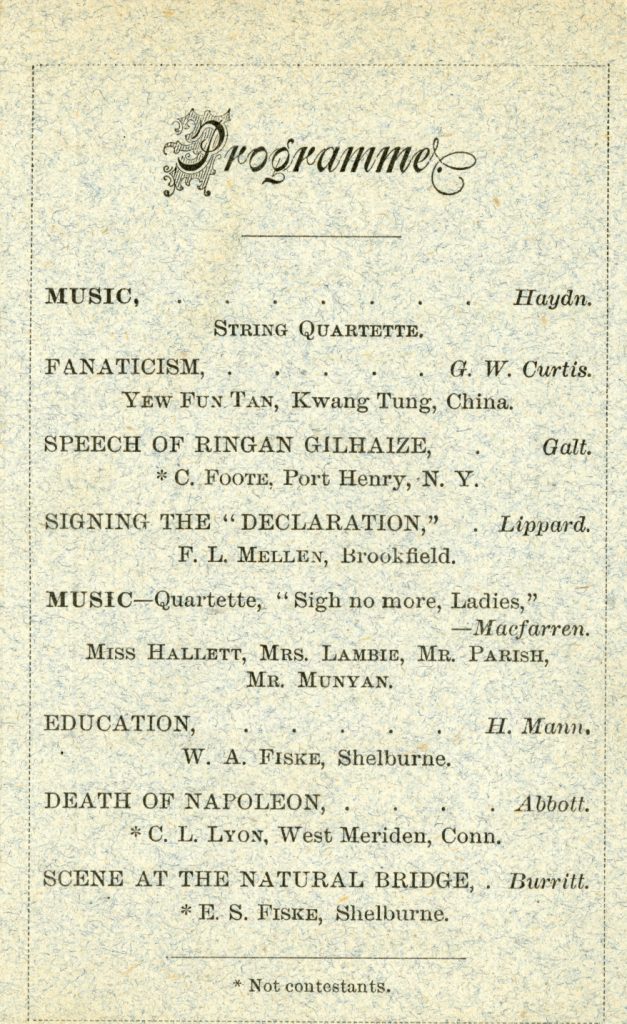
The first task was to recruit a group of students whose parents were willing to permit them to travel abroad for several years. Ultimately, and despite a variety of challenges detailed by Rhoads and LaFargue (Rhoads 13-30; LaFargue 33-34), 120 boys, most in early adolescence and a majority from rural areas neighboring Guangdong in the South and Hangzhou in the East, were selected. Few came from the North, those only toward the end of the program. None came from the ruling Manchu families (LaFargue 34). The boys were gathered at a school in Shanghai for initial orientation and English study.
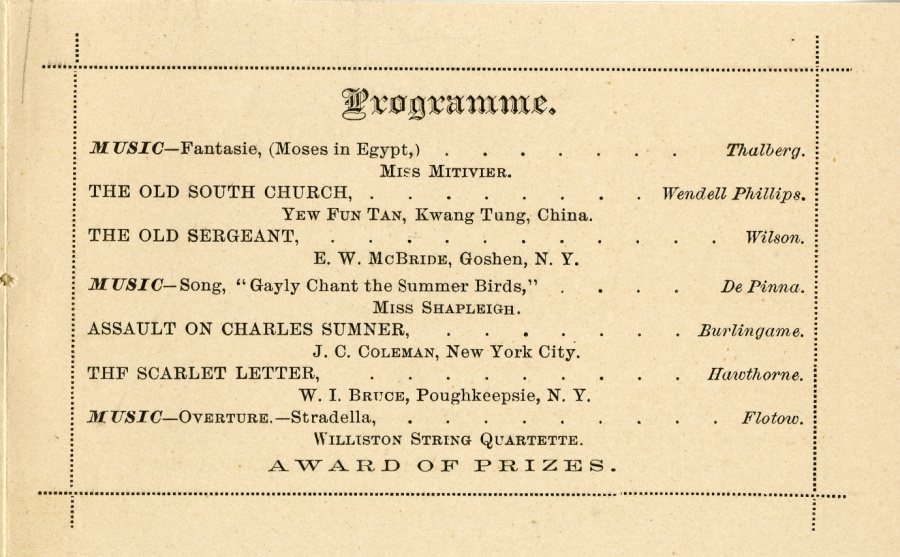
Management of the program in the United States would be by a Chinese Educational Commission (CEC), headquartered in Yung Wing’s old student hometown of Hartford, Connecticut. Yung and a Chinese scholar, Chun Lanbin, were named Commissioners. In 1871 they traveled to Hartford to make arrangements for the boys’ arrival. The students, most aged 12-14 (Rhoads 18), would come in four groups, 1872-1875. They were placed with host families in central Connecticut and Massachusetts, and divided their study time between local schools and the CEC. Following two or three years of preparatory education, each student would enroll in a public or private secondary school in the Connecticut Valley. From 1875 to 1881, eleven students from the first two groups would attend Williston Seminary. They were:
Chen Ronggui (Yung Kwei Chin), class of 1879s*, attended 1876-79
Cheng Daqi (Ta Chi Tsing), class of 1879c, attended 1876-77
Liu Jiazhao (Kia Chau Low), class of 1880c, attended 1876-80
Tan Yaoxun (Yew Fun Tan), class of 1879c, attended 1876-79
Fang Boliang (Pah Liang Fong), class of 1880c/1880s, attended 1876-80
Kuang Yonzhong (Yung Chung Kwang), class of 1879s, attended 1876-79
Wang Fengjie (Fung Kai Whang), class of 1879s, attended 1876-79
Zhang Xianghe (Cheong Cheung Woo), class of 1880s/1881c, attended 1877-79
Kuang Jingyang (King Yang Kwong), class of 1880s/1881s, attended 1877-80
Kuang Xianzhou (Ying Chow Kwong), class of 1880s/1881s, attended 1877-80
Yang Zhaonan (Siu Nam Yang), class of 1880s, attended 1877-79
(*The designations “s” and “c” following the class year denote Williston Seminary’s two curricular divisions, Scientific and Classical. Fang Boliang and Zhang Xianghe switched divisions during their times at Williston. Zhang Xianghe and the Kuang brothers appear to have transferred to later classes.)

A Note on Names
For this article we have followed Professor Rhoads’ lead and rendered all Chinese names using the modern Pinyin system of Chinese transliteration, developed in the 1950s. It differed from the older and less consistent Wade-Giles system, used by Thomas LaFargue. In the 19th century there was no translation standard at all. In the list above, the names in parentheses are those that appear in the Annual Catalogue of Williston Seminary’s rosters. Chinese and Pinyin practice places the surmame first; Williston followed English convention and placed it last – most of the time. To add to the confusion, not only are LaFargue’s name renderings often different, but students’ names are spectacularly inconsistent from one catalogue to the next. Kuang Jingyang and Kuang Xianzhou appear as Kwang and Kwong in alternate years. Tan Yaoxun is rendered Yan Fun Tan and Yew Fun Tan in different volumes. Liu Jiazhou is listed three ways – Kia Chau Lew, Kia Chan Low, and Kia Chau Low, while Zhang Xianghe’s name seems miles away from Williston’s “Cheong Cheung Woo.” Happily, Rhoads has provided a table of accurate pairings (51-54).
Expectations
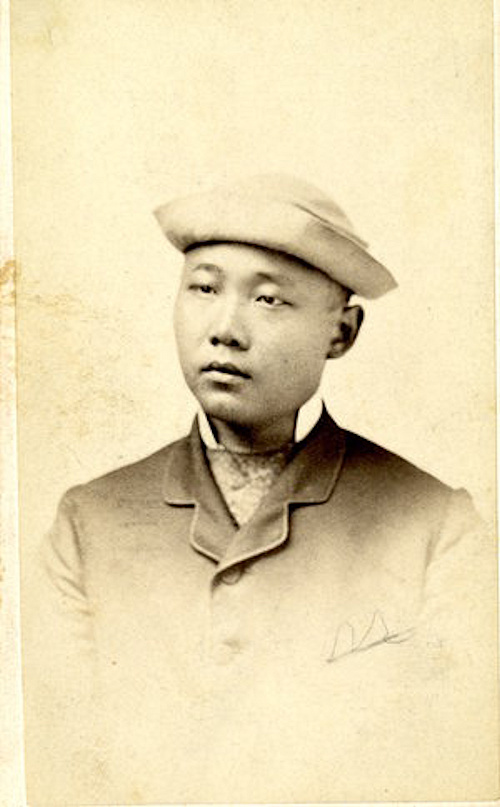
CEM had very clear expectations for its young gentlemen. Once accepted into the program, they were considered to have passed the first level of civil service examinations, and were now government employees, even granted a stipend to cover clothing and travel expenses. They were to obtain American secondary educations and continue at American colleges, then return to China to share what they had learned. They were expected never to abandon their national cultural identites. This included not cutting their queues and appearing only in traditional robes (Rhoads 29-30, 148-150). The last injunction proved impractical. Not only did the boys often draw undue attention and ridicule upon themselves, but growing adolescents need new clothes. The dress code was modified so that students were required to wear Chinese clothing only when returning to CEM headquarters, or at official functions (Rhoads 149).
Continue reading

